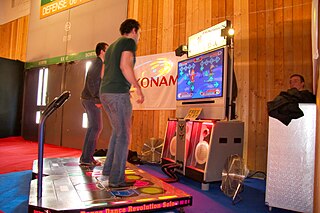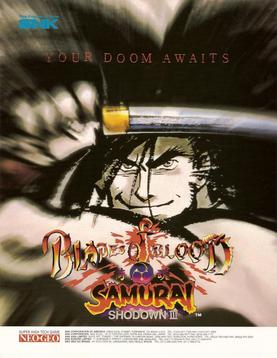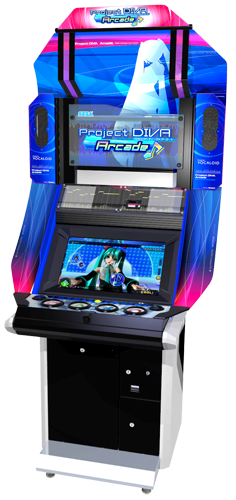Dance Dance Revolution (DDR) is a music video game series produced by Konami. Introduced in Japan in 1998 as part of the Bemani series, and released in North America and Europe in 1999, Dance Dance Revolution is the pioneering series of the rhythm and dance genre in video games. Players stand on a "dance platform" or stage and hit colored arrows laid out in a cross with their feet to musical and visual cues. Players are judged by how well they time their dance to the patterns presented to them and are allowed to choose more music to play to if they receive a passing score.

Soul Edge is a fighting game developed by the Namco team Project Soul and published by Namco as the first installment in the Soulcalibur series of 3D fighting games. Introduced at the JAMMA trade show in November 1995, the full arcade game was released in early 1996, while later in December an upgraded and expanded version of the game was ported to the PlayStation. The PlayStation version was renamed Soul Blade in North America, Europe, and Australia.

Ehrgeiz, fully titled Ehrgeiz: God Bless the Ring, is a 3D fighting video game developed by DreamFactory and published by Namco in 1998 for the arcade platform. It was first ported to the PlayStation and published by Square Co. in 1998, then to Japan's PlayStation Network by Square Enix in 2008.

Beatmania IIDX (IIDX) is a series of rhythm video games, that was first released by Konami in Japan on 26 February 1999. Beatmania IIDX has since spawned 31 arcade releases and 14 console releases on the Sony PlayStation 2. It is the sequel to the beatmania game series, and is part of the Bemani line of music games.
Bemani, stylized as BEMANI, is Konami's music video game division. Originally named the Games & Music Division (G.M.D.), it changed its name in honor of its first and most successful game, Beatmania, and expanded into other music-based games, most notably rhythm games such as Dance Dance Revolution, GuitarFreaks, and DrumMania.

Track & Field, also known as Hyper Olympic in Japan and Europe, is a 1983 Olympic-themed sports video game developed by Konami for arcades. The Japanese release sported an official license for the 1984 Summer Olympics. In Europe, the game was initially released under the Japanese title Hyper Olympic in 1983, before re-releasing under the US title Track & Field in early 1984.

A dance pad, also known as a dance mat or dance platform, is a flat electronic game controller used for input in dance games. Most dance pads are divided into a 3×3 matrix of square panels for the player to stand on, with some or all of the panels corresponding to directions or actions within the game. Some dance pads also have extra buttons outside the main stepping area, such as "Start" and "Select". Pairs of dance pads often are joined, side by side, for certain gameplay modes.

Gitadora is a music video game series produced by Konami. The series consists of two games, GuitarFreaks and DrumMania, where players use game controllers modeled after musical instruments to perform the lead guitar, bass guitar and drums of numerous songs across a wide range of genres by matching scrolling musical notes patterns shown on screen. Players are scored for successfully-hit notes, but may fail a song if they miss too many notes. The series has featured numerous game modes, and supports both single-player and multiplayer modes where up to three players can perform together. Some earlier versions of the game could also be linked with Keyboardmania.

Pop'n Music, commonly abbreviated as Pop'n, PM or PNM and stylized as pop'n music, is a music video game series in the Bemani series made by Konami. The games are known for their bright colors, upbeat songs, and cute cartoon character graphics. Originally released in 1998, the series has had 22 home releases in Japan as well as 30 mainline arcade versions.

Rhythm game or rhythm action is a genre of music-themed action video game that challenges a player's sense of rhythm. Games in the genre typically focus on dance or the simulated performance of musical instruments, and require players to press buttons in a sequence dictated on the screen. Many rhythm games include multiplayer modes in which players compete for the highest score or cooperate as a simulated musical ensemble. Rhythm games often feature novel game controllers shaped like musical instruments such as guitars and drums to match notes while playing songs. Certain dance-based games require the player to physically dance on a mat, with pressure-sensitive pads acting as the input device.
Densha de Go! is a Japanese train simulation game series originally produced by Taito and more recently by Square Enix and Railfan Holdings Co., Ltd. The series started with a 1996 arcade version and was first released in a home version for the PlayStation in 1997. There are also PC versions released by the Japanese publisher Unbalance. All of the games in the series are exclusively available in Japanese.

Puzzle Bobble 2 is a tile-matching video game by Taito. The first sequel to Puzzle Bobble, it is also known in Europe and North America as Bust-A-Move Again for arcades and Bust-A-Move 2: Arcade Edition for home consoles. Released into the arcades in 1995, home conversions followed for the PlayStation, Sega Saturn, Nintendo 64, and Windows platforms. The game was included in Taito Legends 2, but the US arcade version was included on the US PS2 version instead. Further ports for the Nintendo Switch, PlayStation 4, and Xbox One were released by City Connection alongside Puzzle Bobble 3 in February 2023.

Samurai Shodown III: Blades of Blood is an arcade game developed by SNK and released on November 15, 1995. It is the third game in SNK's Samurai Shodown series of fighting games. While it is the third game in the main series, it is the first part of a two-chapter story that is chronologically set between the events of Samurai Shodown and Samurai Shodown II.

Bust A Groove 2 is a rhythm game developed by Metro and published by Enix for the Sony PlayStation in Japan on April 15, 1999 and in North America on August 22, 2000 and is the sequel to Bust A Groove. The game was originally released in Japan as Bust a Move 2: Dance Tengoku Mix, and was never released in Europe.

"Bust a Move" is a song by British-American rapper Young MC from his 1989 debut album, Stone Cold Rhymin'. The song is built on a sample of "Found a Child" by the group Ballin' Jack. The drums, produced by a LinnDrum, are sampled from the song "Radio-Activity" by RoyalCash. The breakdown segment contains a combination of beats sampled from the songs "Scorpio" by Dennis Coffey and the Detroit Guitar Band, and "Daytime Hustler" by Bette Midler. "Bust a Move" also featured guest vocals by Crystal Blake and bass guitar by Red Hot Chili Peppers bassist Flea, who both appear in the music video.
The 1990s was the third decade in the industry's history. It was a decade of marked innovation in video gaming. It was a decade of transition from sprite-based graphics to full-fledged 3D graphics and it gave rise to several genres of video games including, but not limited to, the first-person shooter, real-time strategy, survival horror, and MMO. Arcade games, although still very popular in the early 1990s, began to decline as home consoles became more common. The fourth and fifth generation of video game consoles went on sale, including the Sega Genesis, Super Nintendo, Sega Saturn, PlayStation, Nintendo 64, and Game Boy Color. Notable games released in the 1990s included Super Mario World, Sonic the Hedgehog, Street Fighter II, Mortal Kombat, Killer Instinct, Tekken,Doom, Wolfenstein 3D, Quake, Duke Nukem 3D, Final Fantasy VII, Unreal Tournament, Star Fox, Half-Life, Grand Theft Auto, Super Mario 64, Pokémon Red and Blue, NBA Jam,Daytona USA, GoldenEye 007, System Shock 2, Civilization,Ridge Racer, Sonic Adventure, Gran Turismo, Super Mario Kart, Pokémon Gold and Silver,Castlevania: Symphony of the Night, Super Metroid, Silent Hill, The Legend of Zelda: Ocarina of Time, Crash Bandicoot, Spyro The Dragon, Fallout, Metal Gear Solid, Diablo, Virtua Fighter, Tomb Raider,Sega Rally Championship, Wing Commander,Super Smash Bros, Secret of Mana,Thief: The Dark Project, Age of Empires, Nights into Dreams, Panzer Dragoon, Gunstar Heroes, EverQuest, Chrono Trigger, Battletoads, Worms, Micro Machines, Streets of Rage 2,Baldur's Gate,Donkey Kong Country, Wipeout, The Legend of Zelda: A Link to the Past,Lemmings, EarthBound, StarCraft, Banjo-Kazooie, PaRappa the Rapper, Resident Evil, Tony Hawk's Pro Skater, Soulcalibur, Command & Conquer, and Dance Dance Revolution.

DJMax Portable Clazziquai Edition is a music video game published and developed by Pentavision in South Korea for the PlayStation Portable released on October 24, 2008. This is the third title for the PlayStation Portable from in the DJMax Portable series after DJMax Portable 2. The game features songs from the Korean band Clazziquai.

Um Jammer Lammy is a rhythm video game developed by NanaOn-Sha and published by Sony Computer Entertainment for the PlayStation video game console in 1999. It is a spin-off follow up to 1996's PaRappa the Rapper, once again featuring the collaboration of music producer and game designer Masaya Matsuura and artist Rodney Alan Greenblat. An arcade version co-developed by Namco, titled Um Jammer Lammy Now!, was released in Japanese arcades in December 1999. The game received generally positive reviews from critics.

Hatsune Miku: Project DIVA Arcade is a 2010 arcade rhythm game created by Sega and Crypton Future Media for arcade machines. The game is a port of the 2009 video game, Hatsune Miku: Project DIVA, with updated visuals and was released on June 23, 2010 in Japan with limited international release in countries such as Singapore. Like the original the game primarily makes use of Vocaloids, a series of singing synthesizer software, and the songs created using these Vocaloids, most notably, the virtual diva Hatsune Miku.

The Groove Coaster series is an iOS / Android and arcade rhythm game franchise developed by Matrix Software and published by Taito. The first Groove Coaster was released for iOS on July 28, 2011. This rhythm game follows a roller coaster type track on screen, where players must make the appropriate controller inputs. Like many rhythm games, a life bar is attached to the game play. Players gain or lose points on the bar depending on the input timings.
















